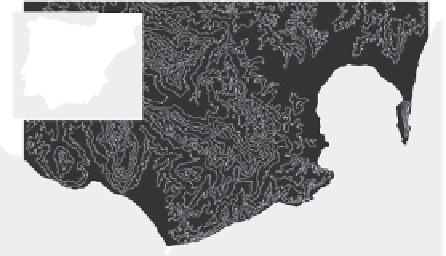Environmental Engineering Reference
In-Depth Information
diversity, for example, takes 30-50 years to recover after logging (Williams et al.,
2001). And even for the bats, essential maternity roosts occur in the hollows of
large mature trees that would take more than 100 years to grow. Thus, sustainable
forestry practice in Australia requires that fi ve such habitat trees are retained per
hectare. The principles of sustainable harvesting will be considered in more detail
in Chapter 7.
4.5.3
Farming the
wind - the spatial
risk of pulverizing
birds
For many species, conservation involves leaving important structures in place, such
as trees of particular species (fl ying squirrels, Section 4.5.1) or age ( bats, Section
4.5.2). With wind farms, on the other hand, it is similarly large structures that are
the problem.
Wind farms can be built on land or at sea, each posing its own threats to migrat-
ing and dispersing birds. On land, soaring birds such as falcons and vultures are at
particular risk of colliding with the turbines (up to 100 m above the ground), par-
ticularly because the engineers often select their locations for the same wind-related
reasons that birds select their routes. Many wind farms are also planned for marine
settings - in Europe, for example, more than a hundred applications have been
submitted (Garthe & Huppop, 2004). Each may consist of as many as 1000 turbines,
up to 150 m tall, as far offshore as 100 km and in water as deep as 40 m. The turbines
may pose risks to migrating birds (from the smallest of songbirds to cranes and
birds of prey) as well as seabirds dispersing locally to fi nd food.
What information is needed before we can get to grips with the risks that wind
farms pose for wildlife? First, there is a need for behavioral information about migra-
tion routes, daily and seasonal dispersal patterns, fl ying height and maneuverability.
However, the vulnerability of individual birds does not necessarily translate into a
signifi cant risk of population decline or extinction. To assess this, information is
also needed about the population size and conservation status of each species. The
race is on to expand the wind-power sector, often in the absence of much detailed
ecological information. Next I describe two studies, one on land and the other at
sea, that begin to build the necessary database.
Two l a nd-b a s e d w i nd farms have already been installed in Gibraltar close to what
has been described as an important migration 'bottleneck' where many soaring birds
funnel through the Straits of Gibraltar en route between Africa and Europe. Both
farms consist of rows of turbines along the north-south ridges of mountains and
hills where they can most effectively harness the prevailing east-west winds (Figure
4.13). The fi rst, along the ridge of the Sierra de Enmedio, has 66 turbines in two
Fig. 4.13
Location of
two wind farms in the
Campo de Gibraltar
region of the Iberian
Peninsula (inset). The
contours are at 100-m
intervals. (After Barrios
& Rodriguez, 2004.)
Emmedio
N
Zorrillos
0
36
km

























































Search WWH ::

Custom Search